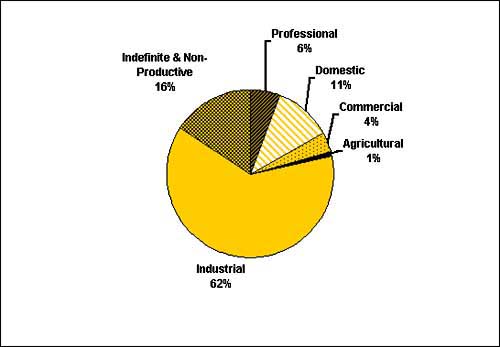|
Home > The Cornish in Latin America > Maps and Graphs > Occupation Categories |
|
For the purposes of this survey the occupations of all migrants were categorised into the five groups as defined in the 1881 Census of Population for England and Wales: category one professional, two domestic, three commercial, four agricultural, five industrial and six indefinite and non-productive. The domestic category includes all those adult female migrants (aged 15 and over) with no specified occupation and those engaged generally in household duties or assisting in their husbandsí businesses. It also includes hotel or boarding house keepers, domestic servants and nurses. Category six comprises migrants whose occupations are indefinite or not stated, persons of rank or property not categorised under any occupation, and scholars and children below 15 years of age. Students over 15 are included under category one. As the stated occupations of female migrants in this study were so few as to be rendered almost statistically invisible, they have been included with the male figures. The industrial category is by far the largest, making up 62 per cent of the total. This includes all those working and dealing in food and drinks, textile fabrics and dress, art and mechanical productions, animal and vegetable substances and minerals. The migration of those connected with the mining industry account for about three quarters of the total migrants in this category, an occupation flow consisting of wheelwrights, blacksmiths, carpenters, masons, ore dressers, miners, pitmen, mine captains, engineers, and agents. It also incorporates butchers, tailors, and grocers who migrated to service the mining communities. By contrast agriculture, the other important Cornish industry, contributes very few migrants to Latin America - just one per cent. Migration schemes set up in the mid 1820s by companies like the Rio de la Plata Agricultural Association, to induce Cornish and other immigrants to sell their farms and emigrate to Argentina, were well known failures. The Catholic Church held much land that was therefore not as easily obtainable as it was in the English speaking countries of Canada or the USA, where it was offered for sale in the early nineteenth century and where many Cornish agriculturists chose to settle. The domestic category at 11 per cent is largely made up of married women who had joined their husbands. Females accounted for 13.5 percent of the total migration flow to Latin America, a ratio of 4:1. The professional class at 6 per cent includes those involved in general or local government, the defense of their country, those engaged in the learned professions or in literature, art or science, and scholars aged 15 or over. The commercial class, accounting for 4 per cent of migrants, includes those engaged in banking and accountancy, clerks, secretaries, merchants, store and shopkeepers and those working in transport such as railway clerks, engine drivers and also merchant seamen. Finally, the indefinite or non-productive category at 13 per cent comprises migrants for whom no stated or confirmed occupation could be ascertained; the remaining 3 per cent of this group is mainly made up of children aged 15 and below. What the occupational classification of migrants to Latin America reveals is the relative homogeneity of the migration flows there that were closely governed by occupational specificity. |
